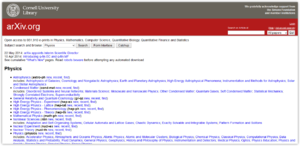History and Structure of arXiv
– Launched in August 1991 by Paul Ginsparg at the Los Alamos National Laboratory (LANL)
– Began as a physics archive but expanded to include other fields like astronomy, mathematics, computer science, quantitative biology, and statistics
– Changed institutions to Cornell University in 2001 and renamed the repository to arXiv.org
– Hosted primarily by Cornell University, with five mirrors worldwide
– arXiv played a significant role in the open access movement and sharing of preprints
– Each arXiv paper has a unique identifier in the format YYMM.NNNNN or arch-ive/YYMMNNN for older papers
– Different versions of the same paper are specified by a version number at the end
– arXiv uses a category system to tag papers with one or more categories, such as q-fin.TR for quantitative finance or hep-ex for high energy physics experiments
– arXiv is not peer-reviewed, but submissions are reviewed by moderators who can recategorize or reject papers
– An endorsement system was introduced in 2004, requiring authors to be endorsed by an established arXiv author to submit papers in certain categories
– Endorsers check if the paper is appropriate for the subject area, without reviewing it for errors
– New authors from recognized academic institutions usually receive automatic endorsement
– Many e-prints on arXiv are also submitted to peer-reviewed journals for publication
– Some influential papers, like Grigori Perelman’s proof of the Poincaré conjecture, remain only as e-prints
– Perelman refused the Fields Medal and Clay Mathematics Millennium Prizes offered for his work on arXiv
– While there are some dubious e-prints on arXiv, they are relatively rare and often re-classified rather than deleted
– arXiv accepts papers in various formats, including LaTeX and PDF printed from non-TeX/LaTeX word processors
– The arXiv software rejects submissions if the final PDF file generation fails, image files are too large, or the submission size exceeds limits
– Authors can store and modify incomplete submissions on arXiv
– arXiv started assigning DOIs to articles in collaboration with DataCite in January 2022
Access and Copyright of arXiv
– Access through the arXiv.org website or mirrors
– Metadata available through OAI-PMH
– Indexed in major consumers of data like BASE, CORE, and Unpaywall
– arXiv is a top 10 global host of green open access
– Researchers can receive daily e-mailings or RSS feeds of submissions
– Some files on arXiv are public domain, some are available under Creative Commons licenses, and most are copyright to the author with a non-exclusive license for distribution by arXiv
Impact and Recognition of arXiv
– The X in arXiv represents the Greek letter chi χ
– arXiv has over 500,000 articles and is a vital library resource
– Monthly submissions to arXiv
– Reports and statistics available on arXiv info
– arXiv intersects with digital library initiatives and supports the Open Archives Initiative protocol for metadata harvesting
– Concerns have been raised about the lack of transparency in the arXiv screening process
Use of arXiv in Computing Research
– Established in 1991 as an e-print archive for physics
– Expanded to include other scientific disciplines such as mathematics, computer science, and biology
– Provides open access to preprints and postprints of scholarly articles
– Allows researchers to share their work before formal publication
– Facilitates collaboration and feedback among researchers
– Over 1.5 million articles available as of 2021
– Widely used by researchers in various fields
– Helps accelerate the dissemination of scientific knowledge
– Enables researchers to stay up-to-date with the latest research
– Increases the visibility and impact of research papers
Use of arXiv in Physics Research and Open Access
– Physicists actively use arXiv for sharing and accessing research papers
– Allows rapid dissemination of findings in the physics community
– Helps physicists to collaborate and build upon each other’s work
– Provides a centralized platform for accessing a wide range of physics literature
– Contributes to the advancement of physics research
– arXiv.org promotes open access to scientific literature
– Supports the principles of free and unrestricted access to knowledge
– Helps overcome barriers to accessing scholarly articles
– Complements traditional publishing models
– Encourages the sharing and reuse of research outputs Source: https://en.wikipedia.org/wiki/ArXiv_(identifier)
arXiv (pronounced as "archive"—the X represents the Greek letter chi ⟨χ⟩) is an open-access repository of electronic preprints and postprints (known as e-prints) approved for posting after moderation, but not peer review. It consists of scientific papers in the fields of mathematics, physics, astronomy, electrical engineering, computer science, quantitative biology, statistics, mathematical finance and economics, which can be accessed online. In many fields of mathematics and physics, almost all scientific papers are self-archived on the arXiv repository before publication in a peer-reviewed journal. Some publishers also grant permission for authors to archive the peer-reviewed postprint. Begun on August 14, 1991, arXiv.org passed the half-million-article milestone on October 3, 2008, had hit a million by the end of 2014 and two million by the end of 2021. As of April 2021, the submission rate is about 16,000 articles per month.
 | |
 | |
Type of site | Science |
|---|---|
| Available in | English |
| Owner | Cornell University |
| Created by | Paul Ginsparg |
| URL | arxiv |
| Commercial | No |
| Launched | August 14, 1991 |
| Current status | Online |
| ISSN | 2331-8422 |
| OCLC number | 228652809 |
